My husband likes building, moving, and rearranging things outdoors. He particularly likes moving really big rocks with the front-end loader on his tractor. When he is not mowing our yard, he is moving rocks and creating outside spaces with various landscaping effects: walls, paths, steps, and… more rocks.
Right now, he is overseeing a landscaping project at our house that has us thinking about how we will furnish our new outdoor spaces. Whether you have a deck, patio, porch, terrace, balcony, rooftop, yard, or, like the ladies on The Golden Girls, a lanai, enjoying your outdoor spaces can be a year-round pleasure in Virginia. A look back at the 3-season January we experienced is evidence of that! With umbrellas for shade and fire pits for heat, you never have to come inside again.
Now that outdoor spaces have become true extensions of our homes, furnishing those spaces means more than plopping a couple of folding chairs next to the grill or sitting at a picnic table in the backyard.
What outdoor furniture is right for you?
Investing in good quality outdoor furniture can make a huge difference in maintenance and longevity. To help you find the best solution for your outdoor space, consider the pros and cons of the most common outdoor furniture materials: metal, wood, plastic, rattan/wicker, and fabrics. With your material options, three factors should be examined: the elements affecting it (wind, sun, rain, freezing temperatures, salt air, and chlorine); maintenance (different materials require different annual treatment to look good); and style (color and design).
 METAL
METAL
Within the metal category, there are four options. Cast iron is durable and heavy, but iron rusts and requires regular cleaning, maintenance, and repainting. Stainless steel is lighter than iron and heavier than aluminum. Marine-grade 316 stainless steel will not rust, but it can be vulnerable to salt air and chlorine, making it a less than optimal choice for beach and pool areas. Regular and cast aluminum does not rust and can be used in any climate. Because it is naturally lightweight, it is often used as the framework under resin wickers and fabrics. However, lightweight pieces are not good in high-wind conditions. Powder-coated metals with UV-proofing that help the finish last longer than regular paint are another option. Chips and scratches are rare, but can expose the base material if left unrepaired.
Pros: There are numerous metal design options.
Cons: It can be hot in the sun and cold in the shade.
Maintenance: Clean with a damp cloth and treat any rust spots or pitting immediately.
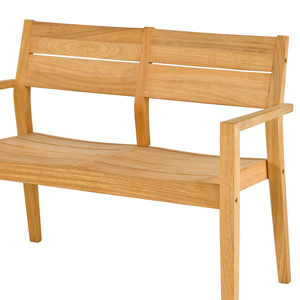 WOOD
WOOD
Pros: Warm, casual feel, and depending on the wood and construction, it can last a lifetime.
Cons: Lower quality woods are not as durable and give way to the elements over time. All woods react to UV exposure and will silver (or bleach out) over time.
Maintenance: Light annual washing is all that’s needed, unless you want to restore the original color. If this is the case, sanding and oiling the wood each season is necessary.
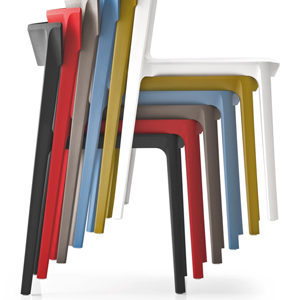 PLASTIC
PLASTIC
Pros: It’s strong and durable, resistant to moisture, rotting, and cracking. Color-fast and stain-resistant when the color is intrinsic to the material, and there are lots of color and style options. Plastic is lightweight.
Cons: Since it’s lightweight, it’s not recommended for windy environments. Poorer quality plastics will crack and break, cannot handle heavier weights, and will fade in the sun.
Maintenance: A sponge, hose, and soap – that’s it!
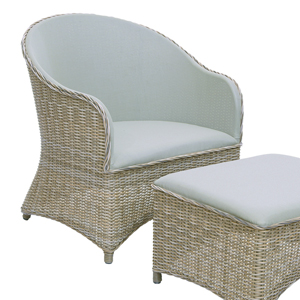 RATTAN and WICKER
RATTAN and WICKER
The synthetic kind, that is! Wicker is the method of weaving, while rattan is the material used. Natural wicker furniture, because it is made from real rattan palm fibers, would fall apart if left in the elements. Synthetic rattan made from polyethylene fibers has allowed us to have the wicker-look outdoors.
Pros: It’s resistant to UV radiation and to water damage. When over aluminum frames, it offers a lightweight outdoor option.
Cons: Can be too lightweight for some high-wind areas.
Maintenance: Spray down with a hose, wipe, or air dry.
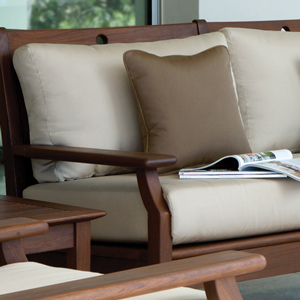 FABRICS
FABRICS
Pros: Gone are the days of scratchy nylons and hard, plastic-y picnic colors. Today’s fabrics are durable, color-fast, fade-resistant, and cleanable! Suppliers produce outdoor textiles that feel like soft, indoor fabrics.
Cons: Mildew can build up on any fabric surface if not cleaned quickly. For best longevity, all fabric items (cushions, umbrellas, pillows) should be covered well or stored indoors during winter months.
Maintenance: Scrub with mild soap and water, or follow vendor’s recommendations. You can even put removable covers in the washing machine on cold water, then air-dry to prevent shrinkage.
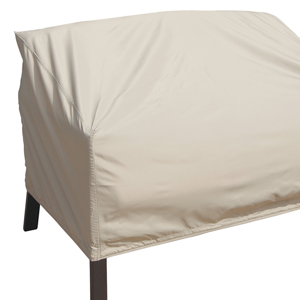 To get the longest life out of your outdoor furniture, particularly if your outdoor space endures harsh winters, store as much as you can in a covered, dry location. If storage is not an option, use covers to protect your furniture investment from the elements.
To get the longest life out of your outdoor furniture, particularly if your outdoor space endures harsh winters, store as much as you can in a covered, dry location. If storage is not an option, use covers to protect your furniture investment from the elements.
My husband and I are now trying to agree on what furniture will be best for our north-facing, wind-enduring outdoor space. It’s an outdoor room, and just like any room in our home, it will have its own individual style. We want an area we can enjoy year-round, so a fire-pit is part of the plan. Fortunately, most now come for use with propane tanks or for hook-up to the city gas line, so we have options. Umbrellas, outdoor rugs, pillows, torches, candles, plants, and sculptures will be the finishing touches that give the space our personality.
Now if only I can get him to stop moving rocks long enough to fire up the grill for dinner, we’ll be all set!
Photo: supplied by LaDiff





